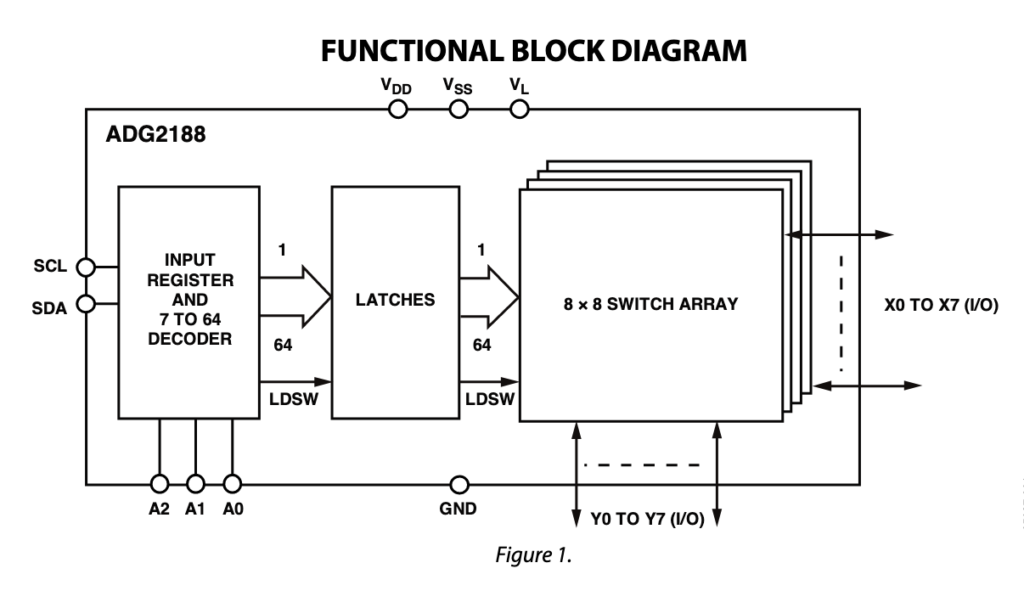Recap
Previously I made the plan to design a sequencer for the original Novation BassStation. This would work by switching the connections on the ribbon cable that connected the keyboard to the motherboard. I mapped out the signal on the ribbon cable, now I needed to decide how to multiplex these signals electronically.
As a reminder here is the mapping of the 16 pins on the ribbon cable:

Not all combinations are used: 25 for the bottom row “on” signal and 25 for the top row “off” signal.

So I need to find a multiplexer that can interface eight input pins by eight output pins.
Eight-to-One multiplexers
The classic 8:1 multiplexer IC is the 74 series logic 74HC4051. This can multiplex a single pin (Z) eight ways (Yx). It’s output is controlled by three pins (S0-S2).

This chip is cheap, readily available under a number of vendors and is simple to program (doesn’t even need a microcontroller). However, it would require eight separate chips to mux an 8×8 matrix. Worse, still that would require 8×3=48 control pins! It’s also slow. But that isn’t a huge concern with audio applications. After all, we’re not building a gigabit network switch.
No, we need something that will handle all 8×8 muxing combinations with only a single serial interface. We need a crosspoint switch IC!
Cross-point Switches
Most crosspoint switches are targetted to the communications market: Highspeed and with differential I/O. Both things we don’t need. What we need is a simple to use, single-ended device. Enter, the Analog Devices ADG2188!

This will mux 8×8 I/O with a single I2C bus (Standard, FastMode and HighSpeed modes). It will switch the BassStation’s 5V signals (15V max) and can use 3.3V logic signals (thanks to a separate Vlogic pin). You can even set a unique I2C address using external pins if needed. What’s not to love? Uh…well the price. This is £8 per chip, which makes it about 20 times more expensive than the 74HC4051. Its also slower than the 74HC4051. Hmmm.
Still, this isn’t a production design. So who cares about price. And at less than 200ns, the propagation delays are still within limits for audio. This will meet the other requirements in a compact and elegant way. And it’s in stock (unlike a lot of other chips at the moment).
Checking the specs
Wait, I forgot something….
The BassStation keyboard/motherboard connections draw about 8mA and the ADG2188 is specified at about 10mA. I get a little nervous that the on-resistance of the ADG2188 switches are not fully specified for my application (+5V VDD and +3.3V VL).
However, the RDS(ON) numbers are pretty normal for a modern switch IC.
For example, compare them with this vishay part. They are certainly lower than those found on the 74HC4051!

Ok, 5V divided by 64Ω is about 78mA. Even if the on-resistance exceeds that, I think we should be able to handle enough current.
Note, I later recalled that the BassStation keyboard/motherboard connections actually draw 8 microamps….not milliamps. Talk about a false alarm 😀
How about that 3.3V logic signal?
Even though its not advertised to use 3.3V logic levels, the I2C interface hysteresis is 0.7V (high) and 0.3V (low) so it should support 3.3V logic without a problem.

Closing thoughts
I can’t help but feel that an analog capable switch is wasted here since we only need simple digital switching. That probably accounts for the price, but after further searching the only alternatives I could find seemed to be designed for more complex digital communication purposes. i.e. using GHz speeds and differential inputs/outputs. Even though they were advertised as 8×8 muxes, many of the pins were reserved for use with specific network protocols and not intended for general use.
One last point: the ADG2188 part only comes in a Lead Frame Chip Scale Package [LFCSP], with only 0.5mm pitch between those pins. Nnnggg thats a bit on the tight side but ok. We will persevere. Experience has shown me that imersion gold-plating PCB finish will be required for anything resembling a QFN package, especially with such a fine pitch.
That adds more to the PCB cost. Looks like this project just bumped itself up to “boutique” class now!
